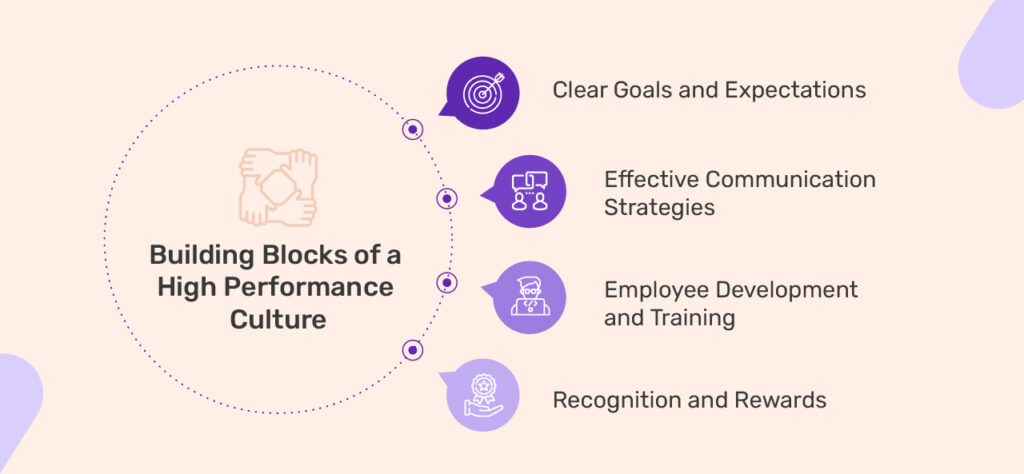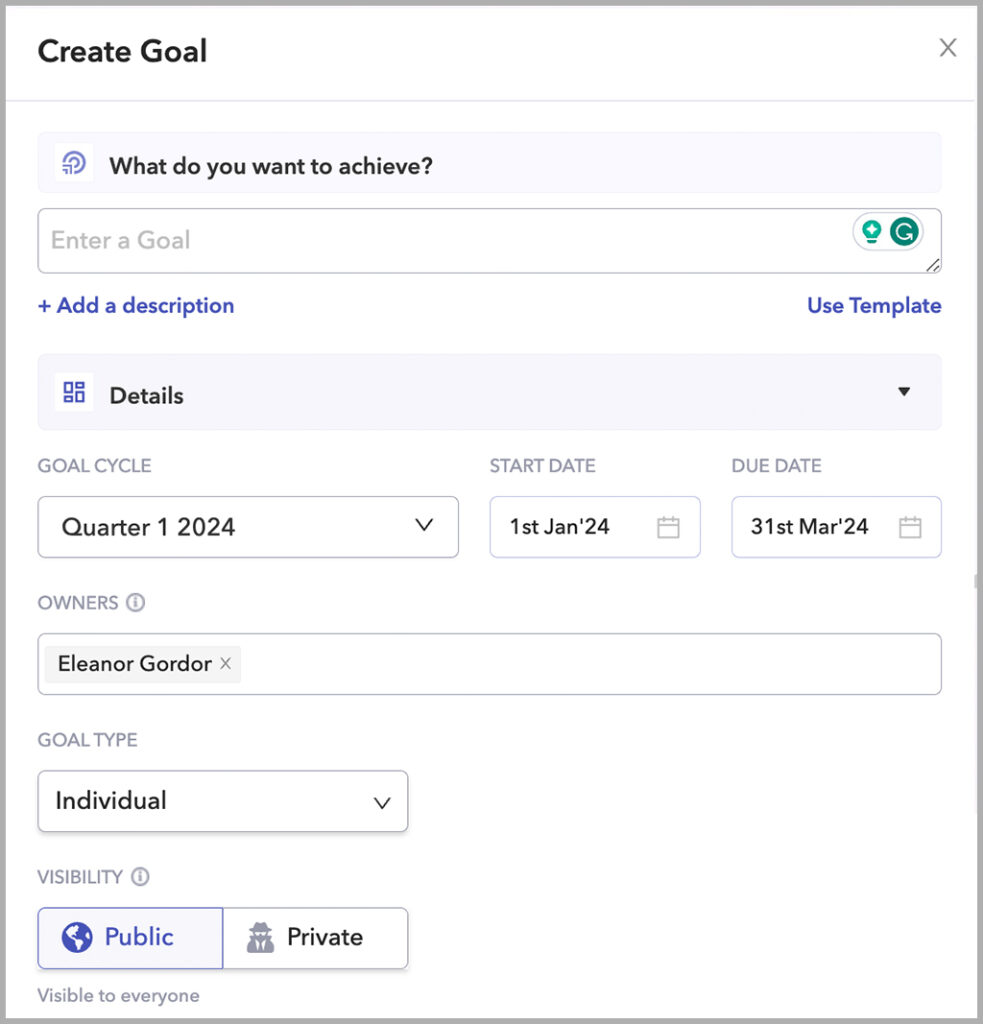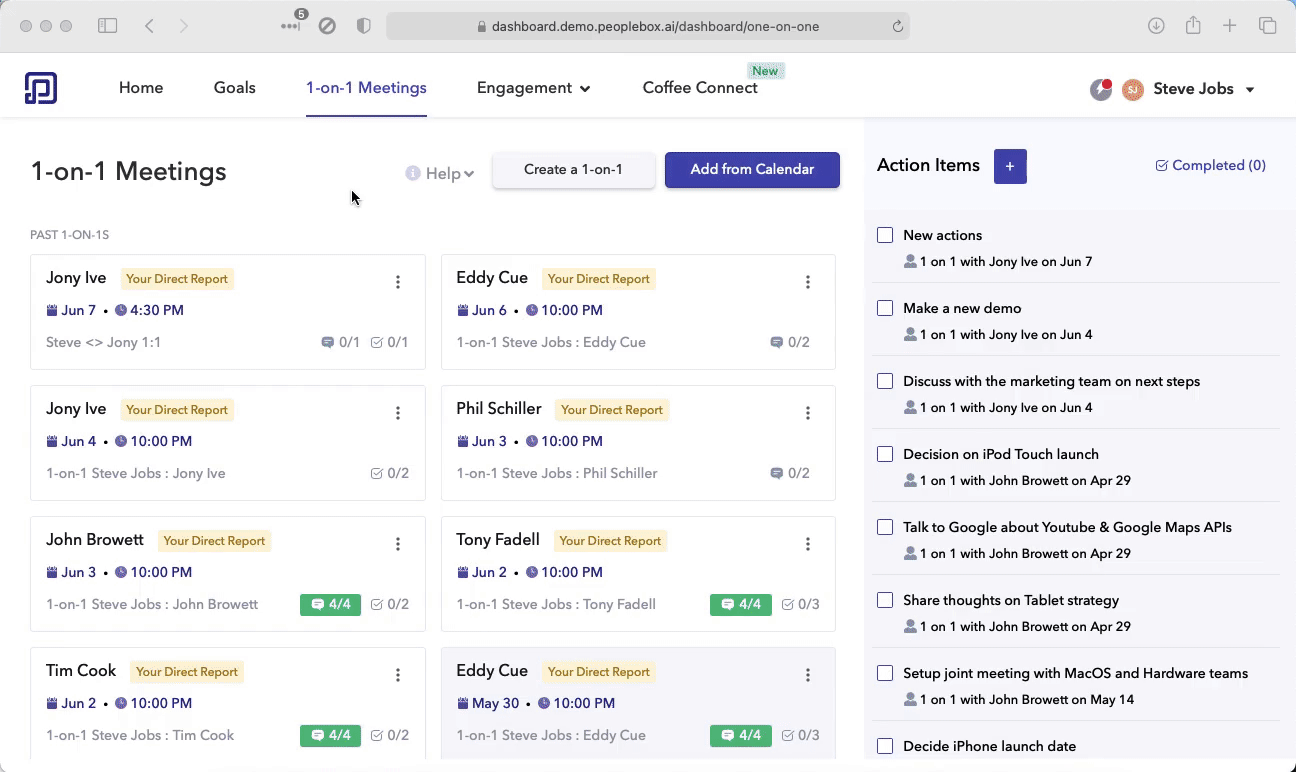Imagine a workplace where employees are energized, engaged, and consistently exceeding expectations. This isn’t just a dream; it’s the reality of a high performance culture.
But how do you create this thriving environment? How do you transform your organization from good to great? In this guide, we’ll unveil the secrets, providing actionable insights and practical tips to cultivate an organizational culture that fuels success.

What is a Culture of High Performance?
A culture of high performance is more than just achieving impressive results. It’s about creating an ecosystem where individuals feel valued, supported, and empowered to consistently excel.
Imagine Maya, a junior developer, feeling overwhelmed by a complex coding task. The team’s clear goals and deadlines provide a roadmap, guiding her efforts and fostering a sense of purpose. Open communication channels allow her to seek help from her mentor, a seasoned developer named John. Through mentorship and training programs, John not only shares coding techniques but also imparts valuable project management skills.
When Maya successfully tackles the task, public recognition at a team meeting boosts her morale and reinforces her contribution. This interconnected web of building blocks fosters a collaborative, supportive environment where Maya thrives, exceeding expectations and contributing to the team’s sustained high performance.
Common Characteristics of a Culture of High Performance
Continuous Improvement: At its core, a high-performance culture is marked by a relentless pursuit of improvement. It encourages individuals and teams to constantly reassess and enhance their skills, processes, and outcomes.
Clear Goals and Expectations: The culture thrives on well-defined, measurable goals and explicit expectations. This clarity provides a roadmap for employees, aligning their efforts with the overarching objectives of the organization.
Effective Communication: Open and transparent communication is the lifeblood of a high-performance culture. It ensures that information flows seamlessly across all levels, fostering collaboration, and minimizing misunderstandings.
Learning and Development: Embracing a mindset of continuous learning is crucial. Organizations with a high-performance culture invest in the development of their workforce, recognizing that an empowered and skilled team is a catalyst for success.
Recognition and Rewards: Acknowledging and appreciating achievements is not just a formality but a fundamental aspect. A high-performance culture recognizes the psychological impact of appreciation, motivating individuals to consistently excel.
Leadership Excellence: Leadership plays a pivotal role in cultivating a high-performance culture. Leaders set the tone, championing the organizational values and inspiring others through their behavior and actions.
Adaptability and Resilience: In a dynamic business environment, adaptability is key. A high-performance culture thrives on resilience, where setbacks are viewed as opportunities to learn and grow, rather than insurmountable obstacles.
Why Building a High Performance Culture is Important
Building a high-performance culture is crucial for several reasons, impacting both your organization and your employees:
For your organization:
-
- Increased Productivity and Profitability: High-performing employees are more engaged, efficient, and innovative, leading to better results and increased profitability.
-
- Reduced Turnover Costs: Engaged employees are less likely to leave, saving your company time and money associated with recruitment and onboarding.
-
- Enhanced Brand Image: A positive culture attracts top talent and fosters customer loyalty, boosting your brand image and reputation.
-
- Improved Adaptability: A culture of continuous learning and open communication allows your organization to adapt to changing market conditions and stay ahead of the curve.
For your employees:
-
- Increased Job Satisfaction and Engagement: Feeling valued, supported, and empowered leads to higher job satisfaction and engagement, promoting well-being and motivation.
-
- Personal and Professional Growth: Opportunities for learning and development help employees reach their full potential, both personally and professionally.
-
- Sense of Belonging and Community: A positive culture fosters collaboration, teamwork, and a sense of belonging, creating a supportive and enjoyable work environment.
-
- Increased Recognition and Reward: High-performing cultures recognize and reward achievements, boosting morale and employee motivation.
Overall, building a high-performance culture creates a win-win situation for both your organization and your employees. It leads to a more productive, profitable, and innovative workplace where everyone feels valued and empowered to succeed.
What are the Building Blocks of a High Performance Culture?
A high-performance culture isn’t built on chance. It’s a carefully constructed ecosystem where individuals and teams thrive, consistently exceeding expectations. But what are the key components that make up this winning formula? Let’s explore the fundamental building blocks:

Let’s take the example of an IT firm to understand this better.
Clear Goals and Expectations
Let’s first take a closer look at the software development team. Here, clear goals mean setting specific, measurable targets for each project. For instance, the team might aim to launch a new software version within a certain timeframe, including specific features. This clarity ensures that every team member knows their role, aligning efforts with the main goal. It not only gives a sense of purpose but also directs everyone’s energy towards a shared achievement.
With employee performance management software like Peoplebox, your team can set multiple goals, aimed at enhancing individual and collective performance. This user-friendly platform empowers teams to establish clear, measurable objectives aligned with the business goals.

Effective Communication Strategies
Effective communication is like the glue that fosters collaboration beyond routine project updates. This means regular team meetings turn into lively discussions about challenges, innovations, and lessons learned. Leadership is crucial in promoting transparent communication, sharing insights into the company’s culture, company values, and vision, and making sure everyone understands the bigger picture and knows their part in achieving it. Utilizing employee pulse surveys and anonymous employee feedback proves invaluable in enhancing communication effectiveness.

Employee Development and Training
Employee growth goes beyond just technical skills; it’s about creating a workplace culture of continuous learning. Think of the investment in workshops, online courses, and mentorship programs as the company’s commitment to growing a well-rounded workforce. For example, junior developers might team up with experienced mentors, learning not just coding but also essential project management skills. This holistic approach ensures that each team member becomes not only a technical expert but also a valuable contributor to the company’s long-term success.
Recognition and Rewards
Recognition and rewards are like throwing a party for both individual and team achievements. Picture the software development team celebrating meeting a tough deadline or coming up with an innovative solution – these milestones deserve public acknowledgement during team meetings. Additionally, the company has a performance-based incentive program tied to specific project achievements. This double approach not only lifts spirits but also cements positive behaviors contributing to ongoing high performance.
Building a high-performance culture is more than just these building blocks. It’s about leadership that cultivates them, nurtures them, and makes them the foundation for a thriving team environment. Let’s explore the crucial role leadership plays in this success story.
Leadership’s Role in Creating a High Performance Culture
A high-performance culture doesn’t magically appear; a company’s culture is set by its leaders and upper management. But how do leaders wield their influence to create an environment where individuals and teams consistently exceed expectations? Let’s delve into the key roles leaders can play in fostering a thriving high-performance ecosystem.
Setting the Tone from the Top
Leadership is more than just titles and directives. It’s about embodying the set of values, behaviors, leadership skills, and mindset you want to cultivate within your organization. This starts with setting a clear tone from the top. This starts with the first step: setting a clear tone from the top.
-
- Be a Champion: Openly advocate for a high-performance mindset, communicating its benefits and importance to the entire organization.
-
- Walk the Talk: Align your actions with your words. Be transparent, approachable, and demonstrate the values you expect from others.
-
- Be Visible and Accessible: Break down barriers and create open ongoing communication channels. Regular interactions with employees foster trust and a sense of belonging.
Building Trust and Accountability
Trust is the foundation of any high-performing team. When employees trust their leaders, they’re more likely to be engaged, motivated, and willing to take risks.
-
- Earn Trust Through Transparency: Share information openly and honestly, even when things are tough. Be upfront about challenges and involve employees in decision-making.
-
- Empower and Delegate: Give direct reports ownership of their work and trust them to make decisions. This fosters a sense of accountability and responsibility.
Provide Constructive Feedback: Feedback should be timely, specific, and actionable. It should focus on development, not just criticism.

Accountability is the flip side of the trust coin. When individuals and teams are held accountable for their actions and outcomes, it drives performance and fosters a culture of continuous improvement.
-
- Set Clear Expectations: Ensure everyone understands their roles, responsibilities, and performance metrics.
-
- Provide Regular Feedback and Coaching: Help employees track progress towards goals, identify areas for improvement, and offer support.
-
- Recognize and Reward High Performance: Celebrate achievements and acknowledge the contributions of individuals and teams.
Adaptability and Resilience
The business landscape is constantly evolving. Leaders need to be adaptable and resilient to navigate environmental and cultural change effectively and ensure their teams can do the same.
-
- Embrace a Growth Mindset: Encourage continuous learning and experimentation. Be open to new ideas and approaches, even if they challenge the status quo.
-
- Foster Psychological Safety: Create an environment where it’s safe to take risks, make mistakes, and learn from them.
-
- Communicate Proactively: Keep employees informed about changes and their implications. Provide clear direction and support during periods of uncertainty.
By playing these key roles, leaders can create a high-performance culture where the foundation of trust, accountability, and adaptability thrive. This empowers individuals and teams to consistently deliver outstanding results, propelling the organization towards long-term success.
Best Practices for Building a High Performance Company Culture
Building a culture of high performance within an organization requires a deliberate and systematic approach.
Goal Alignment
Aligning individual and team goals with organizational objectives is foundational to a high-performance culture. This ensures that everyone is working towards the same overarching goals, fostering unity of purpose and clarity of direction. By aligning goals at all levels of the organization, from senior leadership down to individual contributors, teams can effectively prioritize their efforts and maximize their impact.

Continuous Performance Management
Embracing a culture of continuous performance management involves ongoing feedback, coaching, and growth opportunities. Instead of relying solely on annual performance reviews, organizations should adopt a more agile approach to performance management. Regular check-ins and one-on-ones between managers and employees facilitate open communication, goal progress tracking, and timely course corrections, ultimately driving higher levels of performance and engagement.
Here’s how easy it is to schedule one-on-ones with Peoplebox.

Creating a Feedback Loop
Establishing a feedback-rich environment is critical for fostering growth and improvement. Encouraging open and honest feedback at all levels of the organization enables employees to learn from both successes and failures, driving continuous improvement. By providing timely and constructive feedback, managers can empower their teams to excel and innovate, ultimately contributing to a culture of high performance.
Setting Objectives and Key Results (OKRs)
OKRs are a powerful goal-setting framework that can help organizations align their efforts and drive results. By setting clear and measurable objectives, coupled with key results that indicate progress towards those objectives, teams can stay focused on what truly matters. OKRs provide a roadmap for success, enabling teams to track their performance, identify areas for improvement, and celebrate achievements along the way.
With an OKR management platform like Peoplebox, you can easily set and manage goals of every individual in your organization, from anywhere. It provides a comprehensive view of the entire organization, allowing you to streamline goal-setting processes and ensure alignment across teams and departments.

Employee Empowerment
Empowering employees to take ownership of their work and make decisions fosters a sense of accountability and autonomy. Providing opportunities for skill development, autonomy in decision-making, and recognition for contributions empowers employees to perform at their best. When employees feel empowered and trusted, they are more likely to innovate, collaborate, and drive results, contributing to a culture of high performance.
Promoting Collaboration and Teamwork
Collaboration and teamwork are essential for achieving collective goals and driving organizational success. Encouraging cross-functional collaboration, fostering a culture of knowledge sharing, and promoting teamwork across departments and teams can break down silos and drive innovation. By promoting a collaborative mindset and creating opportunities for teams to work together towards common goals, organizations can leverage the collective intelligence and expertise of their employees to achieve greater results.
Cultivating a Growth Mindset
Fostering a growth mindset, where challenges are viewed as opportunities for learning and development, is essential for building a culture of high performance. Encouraging employees to embrace challenges, persist in the face of setbacks, and seek out opportunities for growth enables them to continuously improve and excel. By promoting a work culture where learning and development are prioritized, organizations can cultivate resilience, innovation, and a drive for excellence among their employees.
Leveraging Technology
Embracing technology is essential for fostering a high-performance culture. Modern tools and platforms streamline processes, enhance communication, and facilitate collaboration. From project management software to communication platforms and performance management systems, technology improves efficiency, transparency, and accountability. By investing in the right technology solutions, organizations create a digital infrastructure that drives productivity, innovation, and success.
Build a Culture of High Performance with Peoplebox
Peoplebox supercharges your journey to a high performance culture by empowering goal setting and management, tracking progress in real-time, and facilitating continuous feedback and coaching.
It provides a central hub where you can set clear, measurable goals aligned with company priorities, ensuring everyone pulls in the same direction. The platform offers real-time insights and analytics so you can identify areas for improvement quickly, and its continuous feedback and coaching features foster a culture of growth and development, boosting performance and engagement across the board.
With Peoplebox, you’ll have the tools and data you need to create a working environment where your employees consistently excel.
Ready to empower your team, track progress effortlessly, and cultivate a culture of continuous growth? Experience the Peoplebox difference firsthand. Talk to us!









